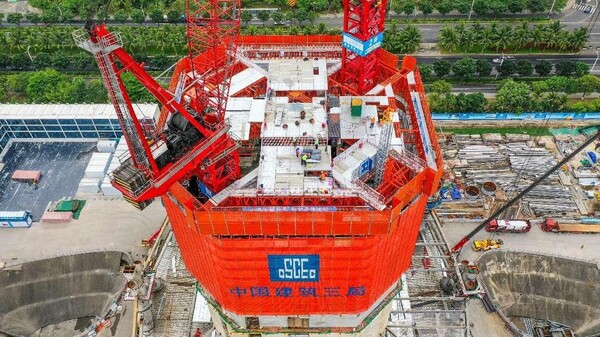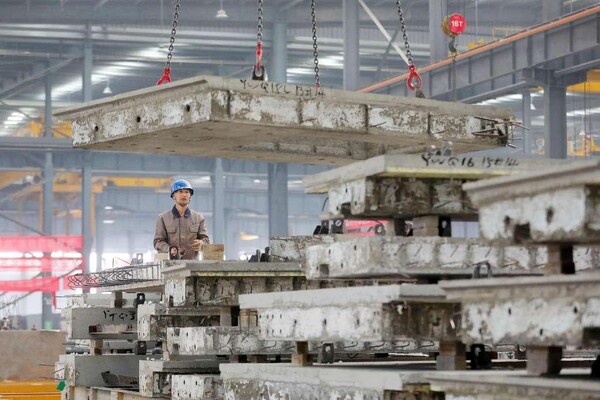By Ding Yiting, People's Daily
The construction industry is one of the pillar industries of China's national economy, with a total output value exceeding 31 trillion yuan ($4.34 trillion) in 2022, providing employment for over 52 million people.
However, the construction industry, as it continues to embrace rapid development, still needs to further enhance its quality despite its huge size.

In recent years, the Chinese construction industry has seized the opportunities brought by the new round of technological revolution and industrial transformation, striving to improve efficiency and reduce energy consumption. As a result, it has achieved continuous transformation and upgrading.
Near Muztagh Ata on the Pamir Plateau in the west of Xinjiang Uygur autonomous region, there stand a row of container-style houses - the first "zero-altitude astronomical observation station" of China, which was officially delivered in 2023.

Although situated at an altitude of over 4,500 meters with an outdoor oxygen concentration of only about 55 percent compared to the plains, people inside the facility would not experience symptoms of altitude sickness such as headaches or insomnia.
The astronomical observation station uses pressurization and other technologies, which means improving the airtightness of the building and injecting air into the interior, to adjust the indoor key human settlement environment indicators to the low altitude level in the plain area, said Wang Kaiqiang, head of the China Construction Institute of Advanced Technology.
To build this facility, the project team has overcome the challenge of high pressure, Wang noted. "While a regular building needs to withstand a few hundred kilograms of pressure per square meter, the number has to reach over 4 tons for 'zero-altitude' buildings," he explained.
"'Zero-altitude' buildings can ensure healthy conditions for people living on the plateau. Currently, the technology has been applied in various scenarios such as hotels and residential buildings, with a cumulative application area of over 2,000 square meters. In the future, with customized and one-stop design services, the market will become even bigger," Wang told People's Daily.
In Shenyang, capital of northeast China's Liaoning province, a 300-meter-high office building is currently underway. Positioning and measurement technicians working on the top floor of the structure are equipped with a "mighty tool" the size of a stationery box - a high-precision positioning receiver enabled by the BeiDou Navigation Satellite System (BDS) for ultra-high-rise, which is capable of achieving accurate positioning at a height of 600 meters with an error margin of only 2 millimeters.
The accuracy of the positioning measurement in construction is crucial for the overall quality and safety of buildings. In the past, this part of work often relied on instruments such as laser plumb bobs and steel rulers. However, buildings above 300 meters are more likely to be affected by strong winds, turbulence and other influences, and violent building oscillations would lead to cumulative errors.
"In previous years, we have successfully overcome the challenge of high-precision measurement of ultra-high-rise buildings through independent research and development. This year, our third-generation equipment has improved its anti-interference capability and stability, enabling precision measurement at an altitude of over 1,000 meters," said Zhang Shengliang, a surveying and mapping expert with China Construction First Group.
According to Zhang, this device has been exported and applied in the construction of over 50 ultra-high-rise projects worldwide.
In recent years, China's construction industry has accelerated its deep integration with advanced manufacturing and new-generation information technology, leading to the emergence of new equipment and continuous breakthroughs in new technologies. By adhering to innovation-driven development, construction companies have constantly expanded the market and improved quality and efficiency.
Another important direction for the transformation and upgrading of the industry is the accelerated development of green buildings and construction methods, which aim to achieve green and low-carbon development of structures throughout their entire lifecycle.
At the construction site of the composite modular construction global R&D center of China Construction Science and Technology Group in Shenzhen, south China's Guangdong province, structures are built like building blocks without supporting templates, tying steel bars. Electromechanical devices, tubes, wires, and curtain walls have all been prefabricated at factories.
"The workload of on-site construction has been reduced to 20 percent of the original, cutting the construction period by half. Additionally, there has been a 70 percent decrease in the emissions of construction waste. The overall cost still remains the same," said Fan Zesen, deputy general manager of China Construction Science and Technology Group.
The construction becomes greener, and the later operation of such structures is also energy-efficient. According to Fan, the project adopts passive techniques to lower the heating and cooling demands of buildings through various means, thus reducing energy consumption.
Additionally, high-performance energy systems are utilized, which store and flexibly use solar power generated by rooftop photovoltaic panels. With a total area of 1200 square meters, these panels generate 220,000 kilowatt-hours of electricity annually, achieving a renewable energy utilization rate of 50 percent, Fan said.
As of the end of 2022, the total area of green buildings constructed nationwide exceeded 10 billion square meters. In 2022, newly constructed green buildings in urban areas accounted for around 90 percent of all new constructions.
Chinese construction companies have accelerated their process of going global, expanding into new regions and enhancing their presence in the global market.
With a total area of approximately 505,000 square meters, the Central Business District project in Egypt's new administrative capital is progressing smoothly. The first section of the Padma Bridge Rail Link Project in Bangladesh, spanning about 170 kilometers, has been put into operation, which is expected to benefit 80 million people directly.
In 2022, the fulfilled turnover of contracts for overseas construction projects by Chinese companies amounted to approximately $154.99 billion, growing 32.9 percent from 2012.
"The construction industry urgently needs to improve the level of industrialization, digitization and intelligence, shifting from quantity expansion to quality improvement, and embarking on a new path of connotative and intensive development," said Jing Wan, vice president of the China Construction Industry Association.

